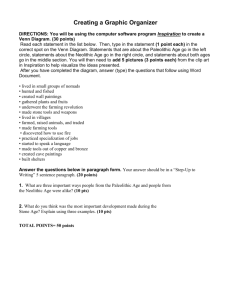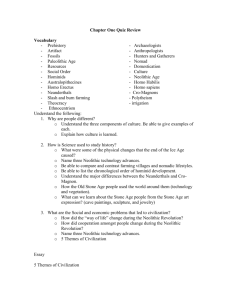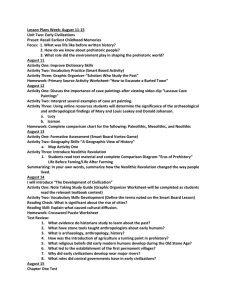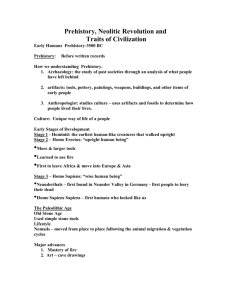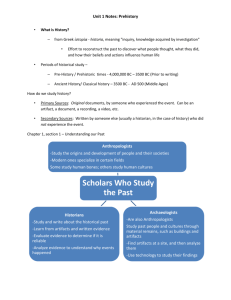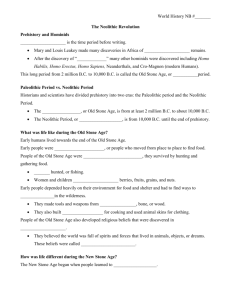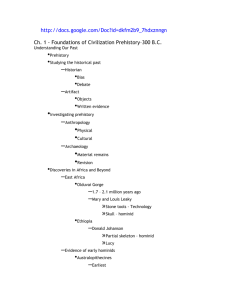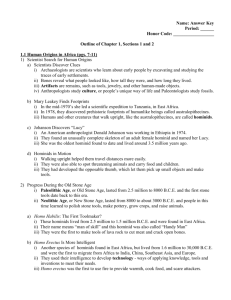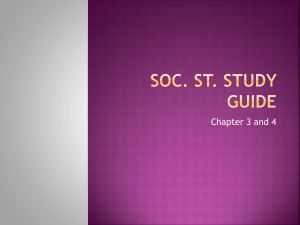Chapter 1 Peopling of the World (Pages 2-25)
advertisement
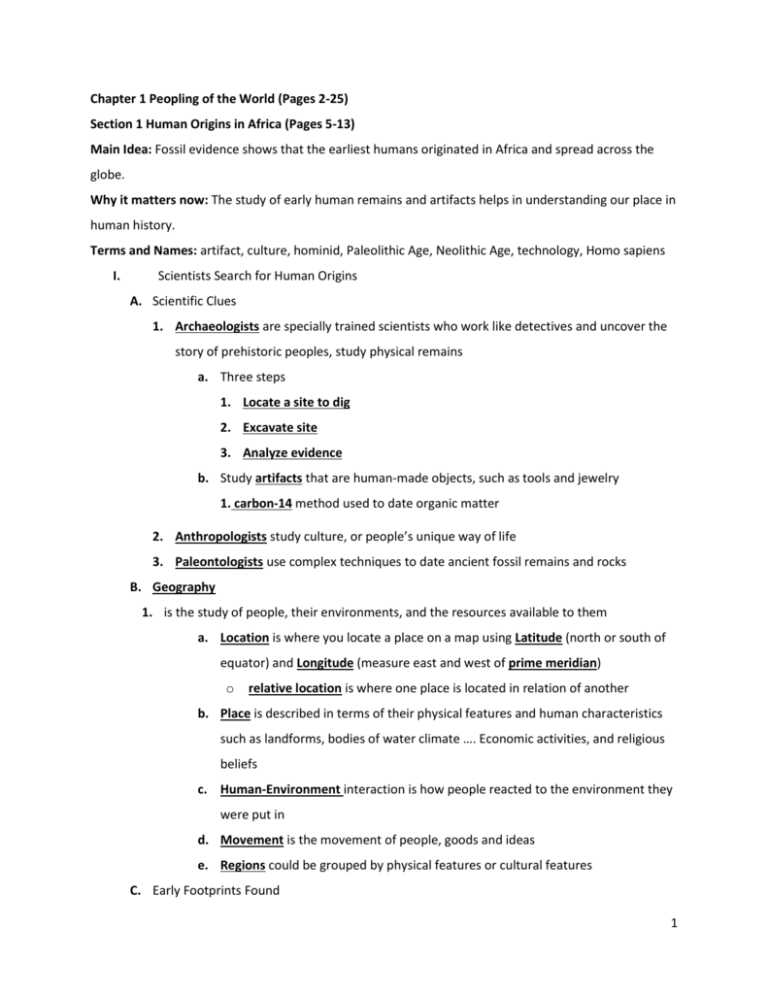
Chapter 1 Peopling of the World (Pages 2-25) Section 1 Human Origins in Africa (Pages 5-13) Main Idea: Fossil evidence shows that the earliest humans originated in Africa and spread across the globe. Why it matters now: The study of early human remains and artifacts helps in understanding our place in human history. Terms and Names: artifact, culture, hominid, Paleolithic Age, Neolithic Age, technology, Homo sapiens I. Scientists Search for Human Origins A. Scientific Clues 1. Archaeologists are specially trained scientists who work like detectives and uncover the story of prehistoric peoples, study physical remains a. Three steps 1. Locate a site to dig 2. Excavate site 3. Analyze evidence b. Study artifacts that are human-made objects, such as tools and jewelry 1. carbon-14 method used to date organic matter 2. Anthropologists study culture, or people’s unique way of life 3. Paleontologists use complex techniques to date ancient fossil remains and rocks B. Geography 1. is the study of people, their environments, and the resources available to them a. Location is where you locate a place on a map using Latitude (north or south of equator) and Longitude (measure east and west of prime meridian) o relative location is where one place is located in relation of another b. Place is described in terms of their physical features and human characteristics such as landforms, bodies of water climate …. Economic activities, and religious beliefs c. Human-Environment interaction is how people reacted to the environment they were put in d. Movement is the movement of people, goods and ideas e. Regions could be grouped by physical features or cultural features C. Early Footprints Found 1 1. Mary Leakey found australopithecines (human like) footprints at Laetoli in Tanzania East Africa 2. Humans that walk upright are called hominids 3. Time before human writing called pre-history D. The Discovery of “Lucy” 1. Donald Johanson found female hominid that was 3.5 million years old (oldest found) a. Advantage walking up right: see threats, carry food and children b. Opposable thumb helped pick up objects and make tools II. The Old Stone Age Begins A. Paleolithic Age 1. 2.5 million years to 8000 B.C. 2. Invention tools, fire, spoken language 3. Homo habalis “man of skill” found by Louis and Mary Leaky (Olduvai Gorge, Tanzania) may have used tools from lava rock to cut meat and crack open bones. Survival easier with tools. 4. Homo erectus “upright man” used intelligence to develop technology—ways of applying knowledge, tools and inventions to meet their needs a. First hominids to migrate or move out of Africa b. First to use fire c. Developed spoken language III. The New Stone Age A. Neolithic age lasted 8000 B.C. to 3000 B.C. 1. Polished stone tools, pottery, grow crops, and raise animals 2. Happened mostly during ice age 3. Homo sapiens “wise men” name for modern humans a. Developed into Cro-Magnons 4. Neanderthal had slanted brows, well-developed muscles, and thick bones a. Lived 200,000 to 30,000 years ago b. Religious beliefs and performed rituals c. Animism is the worshipping of animals d. Lived in caves and had tools B. Cro-Magnons 2 1. Strong, 5’2.5” tall, related to modern humans 2. Superior hunting strategies 3. Advanced spoken language IV. New Findings Add to Knowledge A. Fossils, Tools and Cave Paintings 1. Chad and Kenya found ape type creatures that resembled hominids 2. Ethiopia 2.33 million year jaw with tools show tool making may have started sooner 3. Neanderthal stone flute 43,000 to 82,000 years old found 4. Cave painting dating back 35,000 years ago a. Lascaux Cave Paintings in France 15000-13000 BC b. Sassili n’Ajer, Algeria 6000 B.C. c. Austalian Aborginal , in Kakadu National Park date back 25,000 years d. Cuevas de las Manos, Argentina dtate back 9.5 to 13,000 years ago Section 2: Humans Try to Control Nature (Pages 14-18) Main Idea: Economics- The development of agriculture caused an increase in population and the growth of settled way of life Why it matters now: New methods for obtaining food and the development of technology laid the foundations for modern civilizations. Terms and Names: nomad, hunter-gatherer, Neolithic Revolution, Slash-and-burn farming, domestication I. Early Advances in Technology and Art A. Tools Needed to Survive 1. Nomads were highly mobile people who moved from place to place foraging, or searching for new sources of food a. Hunter-gatherers are people who supply depends on hunting animals and collecting plant foods 2. Modern humans used stone, bone and wood to fashion over 100 different tools B. Artistic Expression in the Paleolithic Age 1. Necklaces, sculptured animals, cave paintings II. The Beginning of Agriculture A. Causes of Agricultural Revolution 3 1. Neolithic Revolution, or the agricultural revolution, is one of the great breakthroughs in history 2. Rising temperatures worldwide provided longer growing seasons and drier land for cultivating wild grasses. B. Early Farming Methods 1. Slash-and-burn farming in which they cut trees or grasses and burned them to clear a field a. Ashes fertilize soil, use field for year or two and move on 2. Otzi the ice man found in the Alps in 1991 a. Six foot long bow, deerskin case of 14 arrows, flint dagger, copper ax etc. 3. Preserved Neolithic village in the Orkney Islands is called Skara Brae C. Domestication of Animals 1. Domestication or taming of animals a. Horses, dogs, goats and pigs b. Nomadic peoples herded sheep, goats, camels etc. D. Agriculture at Jarmo 1. NE Iraq, wild wheat and barley, wild goats, pigs, sheep and horses 2. Settled in Zagros mountains 9000 years ago III. Villages Grow and Prosper A. Farming Develops in Many Places 1. Africa – Nile River had wheat, barley and other crops 2. China – Huang He (Yellow River) cultivated millet and later wild rice 3. Mexico and Central America – cultivation of corn, beans and squash 4. Peru – grow tomatoes, sweet potatoes and white potatoes B. Catal Huyuk 1. “forked mound” south central Turkey 2. 8,000 years ago home to 5-6 thousand people 3. Highly skilled workers 4. Religious shrines, colorful wall paintings 5. Suffered from floods, fire, drought, diseases and attack by nomads to take their wealth Section 3: Civilization (Pages 19-23) 4 Main Idea: Science and Technology- Prosperous farming villages, food surpluses, and new technology led to the rise of civilizations. Why it matters now: Contemporary civilizations share the same characteristics typical of ancient civilizations. Terms and Names: civilization, specialization, artisan, institution, scribe, cuneiform, Bronze Age, barter, ziggurat I. Villages Grow into Cities A. Economic Changes 1. Irrigation systems to have controlled flooding 2. Surpluses allowed people to specialize in pottery, metal working, weaving 3. Traders profited and greater amount of goods were traded 4. Wheel and sail allowed traders to move goods over longer distances B. Social Changes 1. Social classes would become more clearly defined as cities grew 2. Religion more organized, moved away from nature worship to polytheism or belief in many gods II. - How Civilization Develops Civilization, is a complex culture with five characteristics o Advanced cities o Specialized workers o Complex institutions o Record keeping o Advanced technology A. Advanced Cities 1. City is a center of trade for a large area B. Specialized workers 1. Specialization – the development of skills in a specific kind of work 2. Artisans – skilled workers who make goods by hand C. Complex Institutions 1. Government or system of ruling became necessary a. Institution – a long-lasting pattern of organization in a community 2. Religion and economy are other examples 5 D. Record Keeping 1. Officials needed to record tax collections 2. Keep track of calendars for growing and religion 3. Scribes – professional record keepers 4. Cuneiform – Sumerian writing system that used “wedge-shaped” impressions in clay a. Tool called stylus to make markings and bake clay to preserve b. Used to keep track of written history E. Improved Technology 1. new tools and techniques needed to solve problems 2. Sumerians made items out of clay, added tin to copper to create bronze 3. Bronze Age – refers to the time when people began using bronze rather than copper or stone III. Civilization Emerges in UR A. An Agricultural Economy 1. Euphrates river is southern Iraq 2. Irrigation systems, relied heavily on farming B. Life in the City 1. Dirt roads and city walls, windowless square homes a. Wealthy in two story buildings 2. Organized armies C. Ur’s Thriving Trade 1. Bazaar or market place exchange of goods would take place 2. Barter trading goods and services without money 3. Cultural diffusion spread of customs and technologies occurred because of warfare, trade or migration D. The Temple: Center of City Life 1. Tallest structure, pyramid-shaped monument is called a ziggurat “mountain of god” 2. Offerings made to city’s god 6
